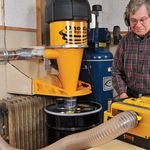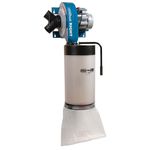A Safer Tablesaw Finally Arrives
But will blade-stopping technology revolutionize the woodworking-tool industry?
Synopsis: Faster than the eye can see, the blade on the SawStop cabinet saw stops when it senses human flesh. A major leap forward in tablesaw safety, the machine has a brake that stops the blade instantly when it comes in contact with the operator, a riving knife that prevents kickback, and a user-friendly blade cover. Woodworker Kelly Mehler tested the SawStop and reports here on his findings.
For years I’ve advocated improvements in the safety design of tablesaws sold in the United States. After testing one of the first SawStop machines shipped from the Geetech factory in Taiwan, I’m happy to report that with this saw, the industry has made a major leap forward. (For a description of the features on this saw, see FWW #171, p. 34.)
This machine offers three valuable safety features: a brake that stops the blade instantly when it comes in contact with the operator; a riving knife that prevents kickback; and a user-friendly blade cover. The blade brake is activated by an electronic sensor in a replaceable cartridge. When it senses contact with human flesh, the cartridge fires into the blade as it drops down below the level of the tabletop. The blade is ruined in the process, and the cartridge will need to be replaced. A cartridge for a 10-in. blade is $59, and one for 8-in. dado sets is $69. I tested this saw twice with hot dogs, once with a chicken leg, and once with sopping-wet pressure-treated lumber. (If there’s any chance that you might activate the brake by mistake, as when cutting pressure-treated lumber, you can override the sensor with a keyed lock.) Each time I tested the device, it worked.
The first test was in front of one of my classes. I stuck a hot dog on the end of a stick and swung it into the moving blade as fast as I could. The result was a 1 ⁄16-in.-deep by 1 ⁄8-in.-wide by 3 ⁄16-in.-long cut. One of the students, a medical doctor, said such a wound would require two or three stitches at most. When I tested the device using a chicken leg pushed into the blade at normal speed, the cut was almost imperceptible.
I’m really pleased to see a riving knife on this saw. Unlike a splitter that stays in one position, a riving knife travels with the blade for height and angle adjustments, and it can be set to within 1 ⁄8 in. of the back of the blade. It not only prevents kickback but also keeps hands away from the back of the blade. This saw comes with a choice of two riving knives—one single-piece unit and one with antikickback pawls that is part of the blade-cover assembly, which is the best of any other designs that I’ve seen.
From Fine Woodworking #174
For the full article, download the PDF below:
Fine Woodworking Recommended Products


Rockler Dust Right 1250 CFM

Starrett 12-in. combination square






















Log in or create an account to post a comment.
Sign up Log in